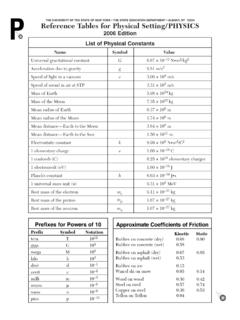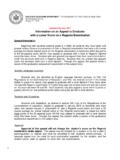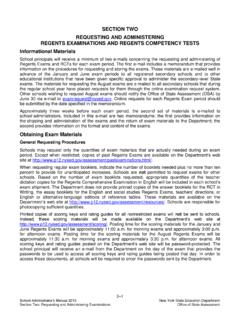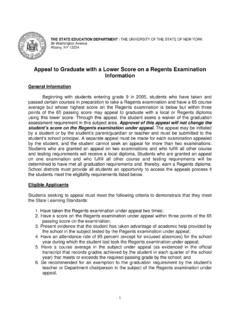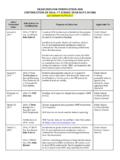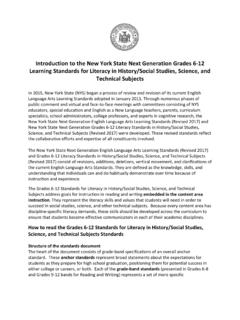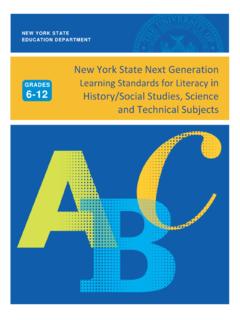Transcription of Smart Schools Bond Act Implementation Guidance
1 Smart Schools Bond Act Implementation Guidance The Smart Schools BOND ACT OF 2014 was passed in the 2014-15 Enacted Budget and approved by the voters in a statewide referendum held during the 2014 General Election on Tuesday, November 4, 2014. The Smart Schools Bond Act authorized the issuance of $2 billion of general obligation bonds to finance improved educational technology and infrastructure to improve learning and opportunity for students throughout the State. The purpose of the Smart Schools Bond Act is to improve learning and opportunity for public and nonpublic school students by funding capital projects to: 1.
2 Install high-speed broadband or wireless internet connectivity for Schools and communities;. 2. Acquire learning technology equipment or facilities, including but not limited to interactive whiteboards, computer servers, and desktop, laptop, and tablet computers;. 3. Construct, enhance, and modernize educational facilities to accommodate pre- kindergarten programs and to provide instructional space to replace classroom trailers;. and/or 4. Install high-tech security features in school buildings and on school campuses, including but not limited to video surveillance, emergency notification systems, and physical access controls.
3 All districts will be required to submit a Smart Schools Improvement Plan to demonstrate how Smart Schools Bond Act funds will be used to provide the educational tools and opportunities students throughout New York State will need to succeed in the 21st century economy. Effective plans should: Include linkages between the district's long-term educational planning and technology investments;. Provide learning opportunities beyond the classroom through the use of technology; and Address the educational needs of all students, including students with disabilities, English language learners and those who have not succeeded in traditional classroom settings.
4 The Smart Schools Review Board will review each district plan for alignment with the goals in this Guidance document and ensure the plan contains all critical elements necessary for the long- term success of this program. Critical elements of a successful plan include: Demonstration of Need: Smart Schools Investment Plans must demonstrate that the district has taken a strategic approach to understanding and meeting the needs of its students. For projects that create additional space for prekindergarten instruction or replace transportable 1. classroom units with permanent space, districts will demonstrate that the proposed projects are consistent with enrollment projections and will be used to create high-quality instructional space for the students who will be served there.
5 Security projects will require a description of the work to be done and the need it will meet. For technology projects, districts will confirm that the proposed technology purchases will be aligned with the district's instructional technology plans. Adequate Technological Infrastructure: In order for students and faculty to receive the maximum benefit from the technology made available under the Smart Schools Bond Act, their school buildings must possess sufficient connectivity infrastructure to ensure that devices can be used during the school day. Smart Schools Investment Plans must demonstrate that sufficient infrastructure that meets the Federal Communications Commission's 100 Mbps per 1,000 students standard currently exists in the buildings where new devices will be deployed, or is a planned use of a portion of Smart Schools Bond Act funds, or is under development through another funding source.
6 Achieving this speed standard is a precondition for the purchase of devices as described further in the school connectivity section. Professional Development: The district must describe a plan to provide professional development to ensure administrators, teachers and staff can employ the technology purchased with funds from the Smart Schools Bond Act to enhance instruction successfully. Districts will demonstrate that they have contacted the SUNY teacher preparation program that supplies the largest number of their new teachers to request advice on this issue. Please note that Smart Schools Bond funds may not be used for professional development.
7 Technical Support: The district should provide sufficient on-going tech support to ensure that the technology (hardware and/or educational technology-related infrastructure) purchased with funds from the Smart Schools Bond Act will be distributed, prepared for use, maintained and supported appropriately. Please note that Smart Schools Bond funds may not be used for technical support. Districts are encouraged to work through BOCES for technical support. Sustainability: As part of their Smart Schools Investment Plans, districts are required to demonstrate a long-term plan to physically maintain the investments made under the Smart Schools Bond Act in a useful condition.
8 This sustainability plan will demonstrate a district's capacity to support the recurring costs of use, for which Smart Schools Bond Act funds may not be used. These recurring costs include, but are not limited to, issues such as device maintenance and timing of replacement, as well as other technical support, internet and wireless fees, maintenance of hotspots etc., ongoing professional development, building maintenance, replacement of incidental items etc., as appropriate. This document describes the process through which school districts will receive their allocations, which will be distributed on a reimbursement basis, the components of the Smart Schools Investment Plan required by the Smart Schools Bond Act, eligible expenditures under the law, the requirements for stakeholder involvement and inclusion of nonpublic Schools , and will address accounting for Smart Schools Bond Act funds.
9 2. Sections of this Guidance Section 1: Overview of the State Review Process for Smart Schools Investment Plans .. 3. Section 2: School District Application Process .. 4. Section 3: Smart Schools Bond Act Allocation .. 7. Section 4: Allowable Expenditures by 8. Install High-Speed Broadband or Wireless Connectivity for Schools .. 8. Install High-Speed Broadband or Wireless Connectivity for Communities .. 11. Acquire Learning Technology Equipment or Facilities (Devices) .. 13. Construct, Enhance or Modernize Educational Facilities to Accommodate Pre-Kindergarten Programs .. 14. Construct, Enhance, and Modernize Educational Facilities to Provide Instructional Space to Replace Classroom Trailers.
10 16. Install High-Tech Security Features in School Buildings and on School Campuses. 17. Section 5: Requirements for Stakeholder Involvement .. 18. Section 6: Inclusion of Nonpublic Schools .. 19. Section 7: Treatment of Smart Schools Bond Act Plans and Funds .. 20. Section 8: Contact Information .. 21. Section 1. Overview of the State Review Process for Smart Schools Investment Plans Smart Schools Investment Plans: The Smart Schools Bond Act requires that school districts develop and receive approval of a Smart Schools Investment Plan from the Smart Schools Review Board, which is comprised of the Chancellor of the State University of New York, the Director of the Budget and the Commissioner of the State Education Department.
